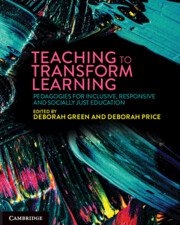Book contents
- Teaching to Transform Learning
- Acknowledgement of Country
- Teaching to Transform Learning
- Copyright page
- Contents
- Contributors
- Acknowledgements
- Introduction Understanding the learner to inform educators’ implementation of pedagogical approaches to transform learning
- Part 1 Pedagogies for all
- Part 2 Engaging pedagogies: making the curriculum come alive for all learners
- 8 Redesigning pedagogy for transformation: creative body-based learning
- 9 Building transformative classrooms through visual and creative body-based learning design
- 10 Co-constructed early childhood pedagogies
- 11 Strengths-based, learner-centred pedagogies: the voice of learners in co-creation and co-design
- 12 Pedagogy informed by community expertise
- 13 Nature-based approaches enhancing experiential learning
- 14 Beyond the four walls
- Part 3 Empowering pedagogies: 21st-century skill development and 22nd-century futures thinking
- Index
- References
9 - Building transformative classrooms through visual and creative body-based learning design
from Part 2 - Engaging pedagogies: making the curriculum come alive for all learners
Published online by Cambridge University Press: 25 October 2024
- Teaching to Transform Learning
- Acknowledgement of Country
- Teaching to Transform Learning
- Copyright page
- Contents
- Contributors
- Acknowledgements
- Introduction Understanding the learner to inform educators’ implementation of pedagogical approaches to transform learning
- Part 1 Pedagogies for all
- Part 2 Engaging pedagogies: making the curriculum come alive for all learners
- 8 Redesigning pedagogy for transformation: creative body-based learning
- 9 Building transformative classrooms through visual and creative body-based learning design
- 10 Co-constructed early childhood pedagogies
- 11 Strengths-based, learner-centred pedagogies: the voice of learners in co-creation and co-design
- 12 Pedagogy informed by community expertise
- 13 Nature-based approaches enhancing experiential learning
- 14 Beyond the four walls
- Part 3 Empowering pedagogies: 21st-century skill development and 22nd-century futures thinking
- Index
- References
Summary
This chapter outlines the theoretical and practical processes of teaching arts integrated curriculum through a transformational learning framework (Mezinow, 2009). A key aim is to highlight how relational knowledge built through dialogic meaning making strategies in visual art provides an approach to curriculum design where students can interrogate their standpoint. We outline pedagogical approaches under the banner of creative and body-based learning (CBL) that focus on transformational learning underpinned by standpoint theory and illustrated by vignettes of three visual art strategies.
Keywords
- Type
- Chapter
- Information
- Teaching to Transform LearningPedagogies for Inclusive, Responsive and Socially Just Education, pp. 137 - 151Publisher: Cambridge University PressPrint publication year: 2024

